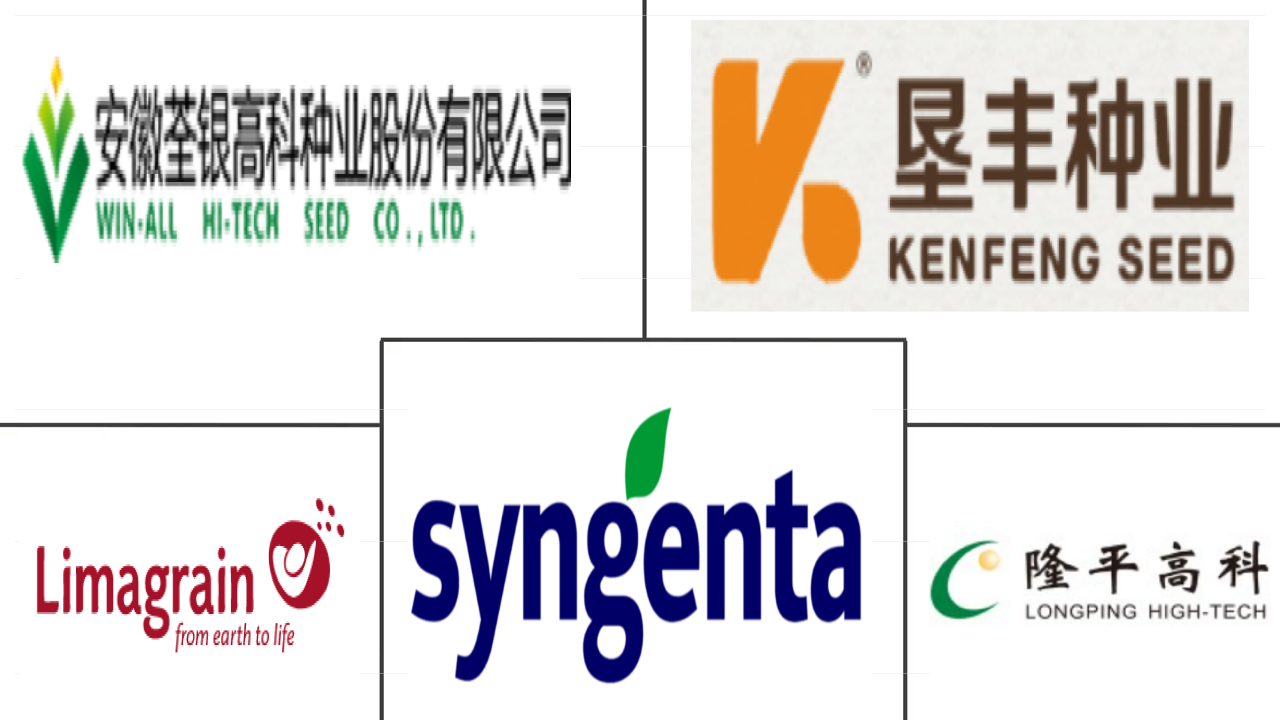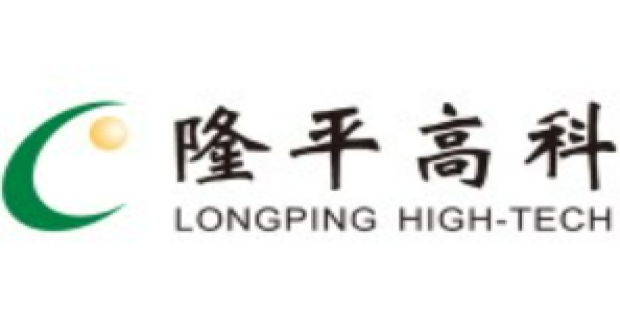Market Size of china seed Industry
| Icons | Lable | Value |
|---|---|---|
|
|
Study Period | 2017 - 2030 |
|
|
Market Size (2024) | USD 11.91 Billion |
|
|
Market Size (2030) | USD 14.13 Billion |
|
|
Largest Share by Breeding Technology | Hybrids |
|
|
CAGR (2024 - 2030) | 2.89 % |
|
|
Fastest Growing by Breeding Technology | Open Pollinated Varieties & Hybrid Derivatives |
|
|
Market Concentration | Low |
Major Players |
||

|
||
|
*Disclaimer: Major Players sorted in no particular order |
China Seed Market Analysis
The China Seed Market size is estimated at 11.91 billion USD in 2024, and is expected to reach 14.13 billion USD by 2030, growing at a CAGR of 2.89% during the forecast period (2024-2030).
11.91 Billion
Market Size in 2024 (USD)
14.13 Billion
Market Size in 2030 (USD)
1.34 %
CAGR (2017-2023)
2.89 %
CAGR (2024-2030)
Largest Market by Crop Family
71.55 %
value share, Grains & Cereals, 2023
China is the largest producer of rice in the world, which is the staple food crop in the country. Corn is also a major grain crop due to its high demand as food and feed.
Largest Market by Breeding Technology
77.65 %
value share, Hybrids, 2023
The largest share of hybrids is due to their high area under cultivation for all hybrid crops and their advantages, such as disease resistance, high yield, and wider adaptability.
Fastest-growing Market by Crop Family
4.75 %
Projected CAGR, Solanaceae, 2024-2030
There is an increase in the demand for Solanaceae crops for the domestic consumption and processing industry, and China is the major producer of tomatoes across the world.
Fastest-growing Market by Breeding Technology
3.47 %
Projected CAGR, Open Pollinated Varieties & Hybrid Derivatives, 2024-2030
The low cost of seeds, high adaptability to local conditions, development of many varieties, and ease of seed production are the major factors driving the demand.
Leading Market Player
4.80 %
market share, Yuan Longping High-Tech Agriculture Co. Ltd, 2022

It is one of the largest companies in the country, expanding its operations through partnerships with world players and product innovations suitable for local climatic conditions.
The prevalence of diseases, the increase in foreign investments, and the increasing number of breeding stations are the major factors driving the seed market in the country
- China uses more high-yielding varieties than any other country, which increases the productivity of crops compared to other countries. With the declining population depending on agriculture, urban and semi-urban greenhouses are increasing in the country.
- In China, hybrids accounted for 77.6% of the seed market in 2022, whereas open-pollinated varieties accounted for 22.4% in the same period. Hybrids are being adopted for corn, cotton, soybean, and vegetables such as tomatoes, cucurbits, brassicas, and leafy vegetables. Moreover, the area sown with hybrids was about 55 million hectares, and the area under open-pollinated varieties was 12.1 million hectares in 2022 because of the demand for high yield and resistance to diseases and insects.
- Transgenic hybrids accounted for 25.1% of the hybrid seed segment in 2022, with approval for commercial cultivation of corn, rice, soybean, and cotton. These crops are being cultivated with traits such as disease resistance, insect resistance, early maturity, and quality attributes such as uniformity and lodging resistance to meet the increased demand from processing industries and households.
- The number of national seed breeding and production bases in China increased to 216 in 2022, and China's liberalized foreign investment resulted in an increase in seed companies from 730 in 2018 to 9,065 by the end of 2022. About 65% of the new companies were registered at the county level. During the forecast period, there will be an increase in hybrids offered by the companies to the growers of grain and other crops.
- The prevalence of diseases, the increase in foreign investments, and the increasing number of breeding stations are the major driving factors that are expected to drive the seed market in the country during the forecast period.
China Seed Industry Segmentation
Hybrids, Open Pollinated Varieties & Hybrid Derivatives are covered as segments by Breeding Technology. Open Field, Protected Cultivation are covered as segments by Cultivation Mechanism. Row Crops, Vegetables are covered as segments by Crop Type.
- China uses more high-yielding varieties than any other country, which increases the productivity of crops compared to other countries. With the declining population depending on agriculture, urban and semi-urban greenhouses are increasing in the country.
- In China, hybrids accounted for 77.6% of the seed market in 2022, whereas open-pollinated varieties accounted for 22.4% in the same period. Hybrids are being adopted for corn, cotton, soybean, and vegetables such as tomatoes, cucurbits, brassicas, and leafy vegetables. Moreover, the area sown with hybrids was about 55 million hectares, and the area under open-pollinated varieties was 12.1 million hectares in 2022 because of the demand for high yield and resistance to diseases and insects.
- Transgenic hybrids accounted for 25.1% of the hybrid seed segment in 2022, with approval for commercial cultivation of corn, rice, soybean, and cotton. These crops are being cultivated with traits such as disease resistance, insect resistance, early maturity, and quality attributes such as uniformity and lodging resistance to meet the increased demand from processing industries and households.
- The number of national seed breeding and production bases in China increased to 216 in 2022, and China's liberalized foreign investment resulted in an increase in seed companies from 730 in 2018 to 9,065 by the end of 2022. About 65% of the new companies were registered at the county level. During the forecast period, there will be an increase in hybrids offered by the companies to the growers of grain and other crops.
- The prevalence of diseases, the increase in foreign investments, and the increasing number of breeding stations are the major driving factors that are expected to drive the seed market in the country during the forecast period.
| Breeding Technology | ||||||||
| ||||||||
| Open Pollinated Varieties & Hybrid Derivatives |
| Cultivation Mechanism | |
| Open Field | |
| Protected Cultivation |
| Crop Type | ||||||||||||||||||||||||||||||||
| ||||||||||||||||||||||||||||||||
|
China Seed Market Size Summary
The China Seed Market is experiencing a steady expansion, driven by the country's significant reliance on high-yielding seed varieties and the increasing adoption of hybrid seeds across various crops. The market is characterized by a substantial shift towards hybrids, which dominate the seed landscape due to their enhanced productivity and resistance to diseases and pests. This trend is supported by the growing number of national seed breeding and production bases, as well as the influx of foreign investments that have spurred the establishment of numerous seed companies. The market's growth is further bolstered by the demand for transgenic hybrids, which offer traits such as disease and insect resistance, early maturity, and improved quality attributes, catering to both processing industries and household needs.
China's agricultural sector plays a crucial role in the global food supply, with the country being a leading producer of grains like rice and corn. The government's policies aim to stabilize corn production while increasing soybean output, reflecting a strategic shift towards reducing import dependence. The cultivation area for oilseeds is expected to rise, driven by high domestic demand and export potential. The market is also influenced by climatic changes, which have heightened the demand for drought-tolerant seed varieties. Major players in the market, including Anhui Tsuen Yin Hi-Tech Seed Industry Co. Ltd, Beidahuang Kenfeng Seed Co. Ltd, and Syngenta Group, are actively involved in developing innovative seed technologies to meet these evolving agricultural demands.
China Seed Market Size - Table of Contents
-
1. MARKET SEGMENTATION (includes market size in Value in USD, Forecasts up to 2030 and analysis of growth prospects)
-
1.1 Breeding Technology
-
1.1.1 Hybrids
-
1.1.1.1 Non-Transgenic Hybrids
-
1.1.1.2 Transgenic Hybrids
-
1.1.1.2.1 Herbicide Tolerant Hybrids
-
1.1.1.2.2 Insect Resistant Hybrids
-
1.1.1.2.3 Other Traits
-
-
-
1.1.2 Open Pollinated Varieties & Hybrid Derivatives
-
-
1.2 Cultivation Mechanism
-
1.2.1 Open Field
-
1.2.2 Protected Cultivation
-
-
1.3 Crop Type
-
1.3.1 Row Crops
-
1.3.1.1 Fiber Crops
-
1.3.1.1.1 Cotton
-
-
1.3.1.2 Forage Crops
-
1.3.1.2.1 Alfalfa
-
1.3.1.2.2 Forage Corn
-
1.3.1.2.3 Forage Sorghum
-
1.3.1.2.4 Other Forage Crops
-
-
1.3.1.3 Grains & Cereals
-
1.3.1.3.1 Corn
-
1.3.1.3.2 Rice
-
1.3.1.3.3 Sorghum
-
1.3.1.3.4 Wheat
-
1.3.1.3.5 Other Grains & Cereals
-
-
1.3.1.4 Oilseeds
-
1.3.1.4.1 Canola, Rapeseed & Mustard
-
1.3.1.4.2 Soybean
-
1.3.1.4.3 Sunflower
-
1.3.1.4.4 Other Oilseeds
-
-
1.3.1.5 Pulses
-
-
1.3.2 Vegetables
-
1.3.2.1 Brassicas
-
1.3.2.1.1 Cabbage
-
1.3.2.1.2 Carrot
-
1.3.2.1.3 Cauliflower & Broccoli
-
1.3.2.1.4 Other Brassicas
-
-
1.3.2.2 Cucurbits
-
1.3.2.2.1 Cucumber & Gherkin
-
1.3.2.2.2 Pumpkin & Squash
-
1.3.2.2.3 Other Cucurbits
-
-
1.3.2.3 Roots & Bulbs
-
1.3.2.3.1 Garlic
-
1.3.2.3.2 Onion
-
1.3.2.3.3 Potato
-
1.3.2.3.4 Other Roots & Bulbs
-
-
1.3.2.4 Solanaceae
-
1.3.2.4.1 Chilli
-
1.3.2.4.2 Eggplant
-
1.3.2.4.3 Tomato
-
1.3.2.4.4 Other Solanaceae
-
-
1.3.2.5 Unclassified Vegetables
-
1.3.2.5.1 Asparagus
-
1.3.2.5.2 Lettuce
-
1.3.2.5.3 Peas
-
1.3.2.5.4 Spinach
-
1.3.2.5.5 Other Unclassified Vegetables
-
-
-
-
China Seed Market Size FAQs
How big is the China Seed Market?
The China Seed Market size is expected to reach USD 11.91 billion in 2024 and grow at a CAGR of 2.89% to reach USD 14.13 billion by 2030.
What is the current China Seed Market size?
In 2024, the China Seed Market size is expected to reach USD 11.91 billion.

